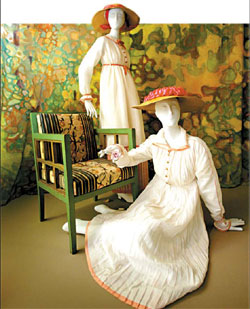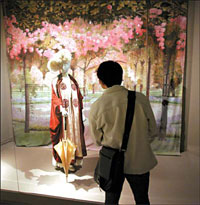Rise and fall of a designer genius
NEW YORK: Behind every great man, there is a great woman. That is perhaps one of the most significant points made by Poiret: King of Fashion, the exhibit at the Metropolitan Museum of Art's Costume Institute. Beyond the importance of Denise Poiret during Paul Poiret's creative peak in the 1910s, the show highlights a largely neglected aspect of the designer's creations: the modernity of his garments and their construction.
Some of the fashions in the show Poiret: King of Fashion are displayed at the Metropolitan Museum in New York. The exhibit celebrates Paul Poiret whose vision led to a new silhoutte that liberated women from the corset. AFP |
Poiret's legacy may be the liberation of women from corseted and reinforced 19th-century silhouettes, but Harold Koda, curator in charge of the Costume Institute, with curator Andrew Bolton, are hoping to shake that sense now.
Bolton said the idea for the exhibit came from a sale of Denise Poiret's personal wardrobe at Paris' Piasa auction house in May 2005. About half of the pieces once belonged to her.
"When people normally talk about Paul Poiret, they refer to the fact that he liberated women from corsets but hobbled their legs with hobble skirts," Bolton said. "What was interesting about the sale was that there was so much more than that. There were jackets with raw edges pre-Martin Margiela or coats made from one piece of fabric."
The Poirets divorced in 1928, shortly before the designer inked his autobiography in which he downplayed his wife's importance - a notion Koda and Bolton hope to correct with the show.
"He saw something in this young woman, and she provided him with a model for the 20th-century woman," Koda said. "She wasn't a Parisienne, and because of that, she was free of that convention that constituted Parisian style at the time. She didn't feel like she had to conform, and there was a synergy between the man who wanted to break the rules and the woman who was his co-conspirator."
That translated into radical designs, such as a baby-doll, off-the-shoulder minidress that Denise Poiret wore without bust support or culottes.
The show highlights the confluence of classicism and orientalism, and Poiret's artistic vein, which resulted in collaborations with Georges Lepape, Raoul Dufy and Paul Iribe. "Poiret saw himself as more of an artist than a designer. And throughout his career, he positioned himself as an artist whose medium of expression was fashion, and he would often collaborate with artists," Bolton said.
Upon entry, visitors find framed pochoirs - hand-colored stenciled illustrations by Lepape featuring Poiret designs. They lead to the Reverend wool coat in 1905, which was designed from one piece of fabric and features chinoiserie motifs.
Just how much a construction wizard Poiret was is underscored in computer-generated animations by digital studio SOFTlab. Two dresses are displayed along animations that chart their creation from one piece of fabric. The pieces come together origami-style, then deconstruct.
Two facing vignettes highlight Poiret's furniture and fragrance interests, which he named for his daughters, Martine and Rosine. Karl Lagerfeld contributed several decor pieces from his personal collections.
One of Poiret's classic outfits includes Chinese motifs. AFP |
The most modern piece, perhaps, is a chemise dress from 1912 displayed on a mannequin lounging on a bed. The T-shaped garment anticipated the sense of dress in the '20s. "This is what has been forgotten about him," Koda said. "He didn't continue to advocate his modernity, because he had done it already. When (Jean) Patou and (Coco) Chanel became advocates of sportswear, he started to advance this fin de siecle beauty and seemed lost."
Koda said Poiret's tale is also a cautionary one. In 1924, he sold off his Martine furniture and Rosine fragrance businesses. A few years later, he was forced to seek backing for his couture house, ultimately losing control over his own creative freedom. He died in poverty in 1944, his fashion star eclipsed by Chanel and Patou.
Poiret: King of Fashion will be on display through August 5.
The New York Times Syndicate
(China Daily 05/25/2007 page18)
















